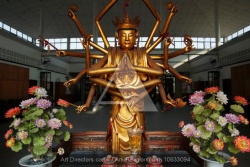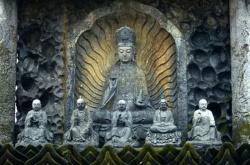Chinese Buddhist Literature
By the end of Tang Dynasty, almost all Buddhist scriptures were translated into Chinese, and many catalogues have been compiled to collect the different translations of all the sutras. The most important catalogues are:
- Zongli zhongjing mulu 綜理眾經目錄 "Comprehensive catalogue of sutras" by Daoan 道安, unfortunately not preserved
- Chu sanzang jiji 出三藏記集 "Collection of records concerning the Tripitaka" by Sengyou 僧祐
- Zhongjing mulu 眾經目錄 "Catalgue of collected sutras" by Fajing 法經
- Kaiyuan shijiao lu 開元釋教錄 "Catalogue of the Kaiyuan era on Buddhism" by Zhisheng 智昇
The whole corpus of Chinese Buddhist writings is compound in the so-called Tripitaka "Threefold basket" (Sanzang 三藏). The modern edition of that corpus was made in Japan under the Taishô Emperor from 1922-1933, therfore called Taisho Daizokyo 大正大藏經 "Great Sutra Storehouse of the Taisho era" (chin.: Dazheng Dazangjing). It is divided into 86 volumes, distributed into the sermons of the Buddha (Sutras; jing 經); the Vinaya writings (rules of discipline; lü 律); the Abhidharma writings ("Higher Subtleties"; chin.: lun 論 or apitan 阿毘曇); Madhyamika ("Middle path", i.e. Great Vehicle; chin.: zhongdao 中道) and Vijnanavada (Idealistic School; chin.: Weishizong 唯識宗) writings; shastra (treatises; chin.: lun 論); commentaries by Chinese monks; literature of the various Chinese schools; historical records; encyclopedias; catalogues.
- 1.-2. Agama Sutras (Ahan 阿含 1-151)
- 3.-4. Past Conditions Sutras (Benyuan 本緣 152-219)
- Puyao jing 普曜經 (sankr.: Lalitavistara) T0186
- Buddhacarita (chin.: Fo Suo Xing Zan 佛所行讚; by Ashvaghosha 馬鳴, translated by Dharmakshema 曇無讖; T0192)
- Parable Sutra (chin. Piyu Jing 譬喻經; T0217)
- 5.-8. Prajna Sutras (Banruo 般若 220-261)
- Great Sutra of Perfection of Wisdom (Da Banruo Boluomi Jing 大般若波羅蜜經, short Da Banruo Jing 大般若經; sanskr.: Maha-Prajna-Paramita-Sutra; translated by Xuanzang 玄奘; T0220)
- Guangzan Jing 光讚經 (sanskr.: Pancavimshatisahasrika-sutra; translated by Dharmaraksha 竺法護; T0222)
- Damingdu Jing 大明度經 (T0225)
- Diamond Cutter Sutra of the Perfection of Wisdom (chin.: Jingang Banruo Boluomi Jing 金剛般若波羅蜜經, short Jingang Jing 金剛經 "Diamond Sutra"; sanskr.: Prajnaparamita-Vajracchedika-Sutra; translated by Kumarajiva 鳩摩羅什; T0235)
- Heart Sutra of the Perfection of Wisdom (chin.: Banruo Bolomiduo Xin Jing 般若波羅蜜多心經, short Xin Jing 心經 "Heart Sutra"; sanskr.: Prajnaparamita-Hrivaya-Sutra; T0251)
- 9. Dharma Blossoms Sutras (Fahua 法華 262-277)
- Lotus Sutra (chin.: Miaofa Lianhua Jing 妙法蓮華經, short Fahua Jing 法華經; sanskr.: Saddharmapundarika-Sutra; translated by Kumarajiva 鳩摩羅什; T0262)
- Zheng Fa Hua Jing 正法華經 T0263
- Wuliangyi Jing 無量義經; translated by 曇摩伽陀耶舎; T0276)
- How the Bodhisattva Samantabhadra Exerts the Law, Explained by the Buddha (chin. Fo Shuo Guan Puxian Pusa Xingfa Jing 佛説觀普賢菩薩行法經, short Puxian Guan Jing 普賢觀經; translated by Dharmamitra 曇無蜜多; T0277)
- 9.-10. Flower Garland Sutras (Huayan 華嚴 278-309)
- Garland Sutra of the Great Universal Buddha (chin.: Dafangguang Fo Huayan Jing 大方廣佛華嚴經; sanskr. Maha-Vaipulya-Avatamsaka-Sutra; translated by Buddhabhadra 佛駄跋陀; T0278)
- 11.-12. Treasure Trove Sutras (Baoji 寶積 310-373)
- Sutra of the Infinite Lifespan, explained by the Buddha (chin: Fo Shuo Wuliangshou Jing 佛說無量壽經, short: "Larger Amitabha Sutra"; translated by Samghavarman 康僧鎧; T0360)
- Sutra on the Contemplation of the Buddha of Infinite Lifespan, explained by the Buddha (chin. Fo Shuo Guan Wuliangshou Fo Jing 佛說觀無量壽佛經, short "Contemplation Sutra"; translated by Kalayashas 畺良耶舎; T0365)
- Amitabha Sutra, explained by the Buddha (chin. Fo Shuo Amituo Jing 佛說阿彌陀經; sanskr: ; translated by Kumarajiva 鳩摩羅什; 366)
- 12. Nirvana Sutras (Niepan 涅槃 374-396)
- Great Parinirvana Sutra (chin. Da Banniepan Jing 大般涅槃經, short: Niepan Jing 涅槃經 "Nirvana Sutra"; sanskr. Maha-Parinirvana-Sutra; translated by Jnanabhadra 慧嚴 and others; T0375)
- 13. Great Collection Sutras (Daji 大集 397-424)
- 14.-17. Miscellaneous Sutras (Jingji 經集 425-847)
- Vimalakirti-Nirdesha-Sutra (chin. Weimojie Suo Shuo Jing 維摩詰所說經, short Weimo Jing 維摩經; translated by Kumarajiva 鳩摩羅什; T0475)
- Lankavatara-Sutra (chin.: Lengqie Abaduoluo baojing 楞伽阿跋多羅寶經, short: Ru Lengqie Jing 入楞伽經; translated by Bodhiruci 菩提流支; T0671)
- 18.-21. Secret Schools (Mijiao 密教 848-1420)
- 22.-24. Vinayas (Lü 律 1421-1504)
- 25. Indian Sutras and Shastras (Shijinglun 釋經論 1505-1535)
- Da Zhidu lun 大智度論 (sanskr. Maha-Prajnaparamita-Shastra), a commentary to the Prajnaparamita-Sutra by Nagarjuna 龍樹, translated by Kumarajiva 鳩摩羅什; T1509
- 26.-29. Abidharma Texts (Pitan 毘曇 1536-1563)
- 30. Madhyamika Texts (Zhongguan 中觀 1564-1578)
- Sanlun 三論 "Three treatises": Zhong Lun 中論 (sankr. Madhyamaka-Shastra; T1564), Shiermen Lun 十二門論 (sanskr.: Dvadashanikaya-Shastra; 1568), and Bai Lun 百論 (sanskr. Shata-Shastra; T1569); all translated by Kumarajiva 鳩摩羅什
- 30.-31. Yogacarin Texts (Yuqie 瑜伽 1579-1627)
- 32. Miscellaneous Shastras (Lunji 論集 1628-1692)
- Satyasiddhi-Shastra (chin. Chengshi Lun 成實論; by Harivarman 訶梨跋摩, translated by Kumarajiva 鳩摩羅什; T1646)
- 33.-44. Commentaries to Sutras, Vinayas and Shastras (Jingshu 經疏 1693-1803, Lüshu 律疏 1804-1815, Lunshu 論疏 1816-1850)
- 44.-48. Writings of Different Schools (Zhuzong 諸宗 1851-2025)
- Zhao Lun "Zhao's Discourses" 肇論, a discussion of problems of Buddhist philosophy in China, by Sengzhao 僧肇 T1858
- Pure Land Treatise (Jingtu Lun 淨土論) by Jiecai 迦才 T1963
- Green Cliff Records (Foguo Huanwu Chanshi Biyan Lu 佛果圜悟禪師碧巖錄, short Biyan Lu 碧巖錄, a collection of Chan riddles by Xuedu Zhongxian 雪竇重顯 and Huanwu T2003
- 48.-52. Historical Writings (Shizhuan 史傳 2026-2120)
- Gaoseng Zhuan 高僧傳 by Huijiao 慧皎, "Biographies of Eminent Monks" T2059
- Hongmingji 弘明集, an apologetic text of Buddhism by Sengyou 僧祐 T2102
- 53.-54. (Shihui 事彙 2121-2136)
- 54. Outer Teachings (Waijiao 外教 2137-2144)
- 55. Catalogues (Mulu 目錄 2145-2184)
- 85. Fragments (Guyi 古逸 2732-2864)
- 85. Apocryph Text (Yisi 疑似 2865-2920)
Other writings that are not encluded in the Tripitaka comprise a vast diversity of biographical, philosophical, encyclopedical and even poetry writings, some freely translated from the Sanskrit original, but there exist also many Buddhist writings by Chinese Buddhists:
- Mouzi lihuo lun 牟子理惑論, an essay about controversies between Buddhism and Chinese tradition (3rd cent.)
- Foguo Ji 佛國記 "Record of Buddhist kingdoms", a report of the traveler Faxian (around 400)
- Fayuan Zhulin 法苑珠林, an encyclopedia by Daoshi 道世
- Many rulers and eminent persons wrote poems about Buddhism and Buddhist life, among them the Empress Wu Zetian.
- Yaoshi Jing 藥師經 "Sutra of the Master of Medicine"
- Dabei Chan 大悲懺 "Great Compassion Penance"
Excursion: While the Mahayana tradition ("Great Vehicle") of Buddhism in China, Korea and Japan is based on the Chinese Tripitaka Canon, the Theravada or Hinayana tradition ("Smaller Vehicle") is based on the Pali Canon (Pali is a Middle Age Indian language). The composition of the Pali Canon is older than that of the Sanskrit Mahayana tradition. The order of writings - and their content - is different to the Chinese Tripitaka. The main sections of the Pali Canon are:
- Vinaya Pitaka ("Basket of Rules"): rules of the monastery community and the stories behind the different rules. 1. Suttavibhanga (basic rules for monks and nuns); 2. Khandhaka (sermons and etiquette); and 3. Parivara (recapitulation)
- Sutta Pitaka ("Basket of Discourses"): the sermons of the Enlightened, divided into five collections: 1. Digha Nikaya ("long discourses", including the Pali Nirvana Sutra); 2. Majjhima Nikaya ("middle-length discourses"); 3. Samyutta Nikaya ("grouped discourses"); 4. Anguttara Nikaya ("further factored discourses"); and 5. Khuddaka Nikaya ("smaller discourses")
- Abhidamma Pitaka ("Basket of Explanations"): Exegeses, Annotations, Researches and Explications to the sutra section, divided into seven books.

